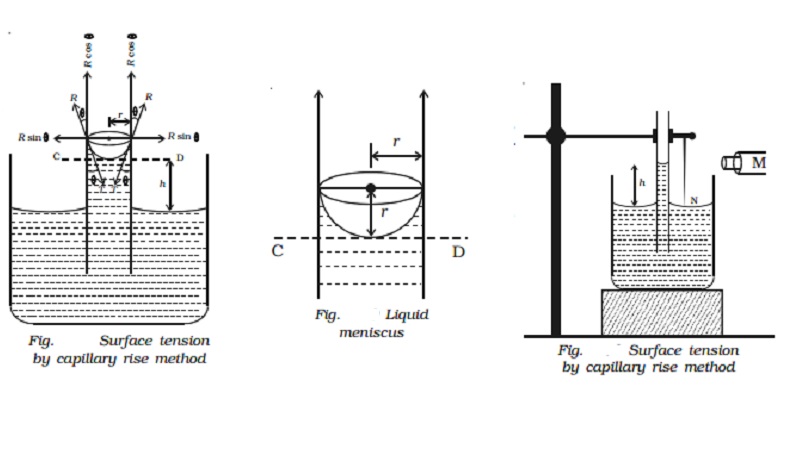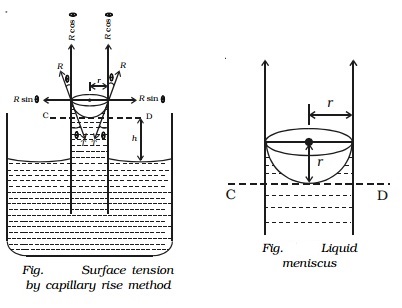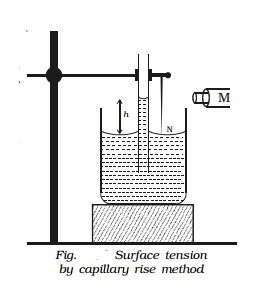Chapter: 11th 12th std standard Class Physics sciense Higher secondary school College Notes
Experimental determination of surface tension of water by capillary rise method

Surface tension by capillary rise method
Let us
consider a capillary tube of uniform bore dipped vertically in a beaker
containing water. Due to surface tension, water rises to a height h in the
capillary tube as shown in Fig.. The surface tension T of the water acts
inwards and the reaction of the tube R outwards. R is equal to T in magnitude
but opposite in direction. This reaction R can be resolved into two rectangular
components.
(i)
Horizontal component R sin θ acting
radially outwards
(ii)
Vertical component R cos θ acting
upwards.
The
horizontal component acting all along the circumference of the tube cancel each
other whereas the vertical component balances the weight of water column in the
tube.

Total
upward force = R cos θ × circumference of the tube
(i.e) F
= 2πr R cos θ or F = 2πr T cos θ
……………(1)
This
upward force is responsible for the capillary rise. As the water column is in
equilibrium, this force acting upwards is equal to weight of the water column
acting downwards.
F =
W ………(2)
Now,
volume of water in the tube is assumed to be made up of (i) a cylindrical water
column of height h and (ii) water in the meniscus above the plane CD.
Volume
of cylindrical water column = πr2h
Volume
of water in the meniscus = (Volume of cylinder of height r and radius r) - (Volume
of hemisphere)
Volume
of water in the meniscus = (πr2 × r) - (2/3 π r3) = 1/3 πr3
Total
volume of water in the tube = πr2 (h+ r/3)
If ρ is
the density of water, then weight of water in the tube is W = πr2
(h+ r/3) ρg ………….(3)
Substituting
(1) and (3) in (2),
T = (h+r/3)r ρg
/ 2cos θ
Since r
is very small, r/3 can be neglected compared to h.
T = hr ρ g / 2 cos θ
For
water, θ is small, therefore cos θ = 1
T = hr ρ g / 2
Experimental determination of surface tension
of water by capillary rise method
A clean capillary tube of uniform bore is fixed vertically with its
lower end dipping into water taken in a beaker. A needle N is also fixed with
the capillary tube as shown in the Fig.. The tube is raised or lowered until
the tip of the needle just touches the water surface. A travelling microscope M
is focussed on the meniscus of the water in the capillary tube. The reading R1
corresponding to the lower meniscus is noted. The microscope is lowered and
focused on the tip of the needle and the corresponding reading is taken as R2.
The difference between R1 and R2 gives the capillary rise
h.

The
radius of the capillary tube is determined using the travelling microscope. If ρ is the density of water then the surface tension of water is given
by T = hrρg /2 where g is the
acceleration due to gravity.
Related Topics